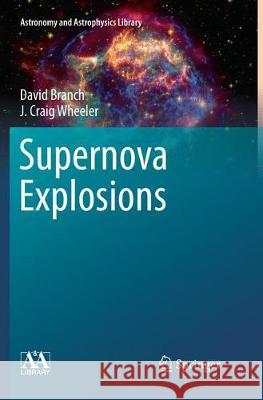Supernova Explosions » książka



Supernova Explosions
ISBN-13: 9783662572238 / Angielski / Miękka / 2018 / 721 str.
Supernova Explosions
ISBN-13: 9783662572238 / Angielski / Miękka / 2018 / 721 str.
(netto: 576,41 VAT: 5%)
Najniższa cena z 30 dni: 578,30
ok. 22 dni roboczych
Dostawa w 2026 r.
Darmowa dostawa!
The authors received the Chambliss Astronomical Writing Award for 2019 from the American Astronomical Society (AAS)
"This book aims to be a resource for those working in the field of supernovae ... the text covers all the basics in fairly good depth, providing ample citations for readers wishing to delve deeper. ... Summing Up: Recommended. Graduate students, researchers, faculty, and professionals." (D. J. Van Domelen, Choice, Vol. 55 (10), June, 2018)
David Branch received his Ph.D. in astronomy from the University of Maryland in 1969. He then served as Postdoctoral Research Fellow at the Goddard Space Flight Center (1969), the California Institute of Technology (1969-70), and the Royal Greenwich Observatory, England, (1970-73). During those years he worked on the spectroscopic determination of the relative abundances of the chemical elements in the Sun and stars, and began to work on the interpretation of the spectra of supernovae. In 1973 he joined the faculty of the University of Oklahoma as Assistant Professor and became Full Professor in 1981. From 1985 to 1990 he served as Chair of the Department of Physics and Astronomy. In 1987 he received the career appointment of George Lynn Cross Research Professor. During his tenure at Oklahoma he also held Visiting-Professor appointments at the University of Texas (1979-80), Oxford University (1980), the University of California, Santa Cruz (1984), and the University of Munich (1987), as well as Visiting Senior Scientist appointments at the Lawrence Berkeley National Laboratory (1991) and the International School of Advanced Studies, Trieste, Italy (1997). He is a member of the American Astronomical Society and the International Astronomical Union. He received the Senior United States Scientist Award of the Alexander Humboldt Foundation, Germany (1988) and the Distinguished Alumnus Award of the Department of Astronomy, University of Maryland (2004). He has published more than 300 refereed scientific papers. At the University of Oklahoma, his research has concentrated on advancing our understanding of the physics of supernova explosions, with emphasis on the interpretation of the spectra of supernovae. He was an early and persistent advocate of using supernovae to determine the history of the expansion rate of the universe.
J. Craig Wheeler received his PhD in physics from the University of Col
Targeting advanced students of astronomy and physics, as well as astronomers and physicists contemplating research on supernovae or related fields, David Branch and J. Craig Wheeler offer a modern account of the nature, causes and consequences of supernovae, as well as of issues that remain to be resolved.
Owing especially to (1) the appearance of supernova 1987A in the nearby Large Magellanic Cloud, (2) the spectacularly successful use of supernovae as distance indicators for cosmology, (3) the association of some supernovae with the enigmatic cosmic gamma-ray bursts, and (4) the discovery of a class of superluminous supernovae, the pace of supernova research has been increasing sharply. This monograph serves as a broad survey of modern supernova research and a guide to the current literature.
The book’s emphasis is on the explosive phases of supernovae. Part 1 is devoted to a survey of the kinds of observations that inform us about supernovae, some basic interpretations of such data, and an overview of the evolution of stars that brings them to an explosive endpoint. Part 2 goes into more detail on core-collapse and superluminous events: which kinds of stars produce them, and how do they do it? Part 3 is concerned with the stellar progenitors and explosion mechanisms of thermonuclear (Type Ia) supernovae. Part 4 is about consequences of supernovae and some applications to astrophysics and cosmology. References are provided in sufficient number to help the reader enter the literature.
1997-2025 DolnySlask.com Agencja Internetowa
KrainaKsiazek.PL - Księgarnia Internetowa









